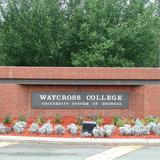- Founded in 1906, South Georgia College is recognized as the oldest publicly supported two-year college in Georgia. It has a long and distinguished history, rich in the tradition of serving the people of the southeast. SGC is fully accredited by the Commission on Colleges of the Southern Association of Colleges and Schools.
School Highlights
South Georgia State College serves 2,286 students (53% of students are full-time).
The college's student-teacher ratio of 10:1 is lower than the state community college average of 18:1.
Minority enrollment is 40% of the student body (majority Black), which is less than the state average of 61%.
Quick Facts (2025-26)
- Enrollment: 2,286 students
- In-state tuition: $3,690
- Out-state tuition: $11,098
- Acceptance Rate: 58%
- Student-teacher ratio: 10:1
- Minority enrollment: 40%
- Source: Integrated Postsecondary Education Data System (IPEDS)
School Overview
The teacher population of 222 teachers has stayed relatively flat over five years.
South Georgia State College
(GA) Community College Avg.
Carnegie Classification
Baccalaureate/Associate's Colleges: Mixed Baccalaureate/Associate's
Associates--Public Rural-serving Medium
Institution Level
Four or more years
At least 2 but less than 4 years
Institution Control
Public
Public
Total Faculty
222 staff
209 staff
School Calendar
Student Body
The student population of South Georgia State College has stayed relatively flat over five years.
The student-teacher ratio of 10:1 has increased from 9:1 over five years.
The South Georgia State College diversity score of 0.57 is less than the state average of 0.71. The school's diversity has stayed relatively flat over five years.
Total Enrollment
2,286 students
2,604 students
Student-Teacher Ratio
10:1
18:1
# Full-Time Students
1,205 students
882 students
# Part-Time Students
1,081 students
1,722 students
# Enrollment Undergraduate
228 students
299 students
# Full-Time Undergraduate Students
1,205 students
929 students
# Full-Time Graduate Students
n/a
87 students
# Part-Time Undergraduate Students
1,081 students
1,848 students
# Part-Time Graduate Students
n/a
53 students
Total Dormitory Capacity
506 students
654 students
% Asian
n/a
4%
% Hispanic
11%
10%
% Black
23%
35%
% White
60%
39%
% Hawaiian
n/a
1%
% Two or more races
2%
3%
% Non Resident races
1%
1%
% Unknown races
2%
7%
Diversity Score
0.57
0.71
College Completion Rate (Students who graduate in less than 4 years)
13%
31%
College Completion Rate (Students who graduate in 4 years or more than 4 years)
17%
24%
Average Graduate Earnings (10 Years)
$35,200
$29,500
Tuition and Acceptance Rate
The public in-state tuition of $3,690 is more than the state average of $3,403. The in-state tuition has grown by 11% over four years.
The public out-state tuition of $11,098 is more than the state average of $7,170. The out-state tuition has grown by 14% over four years.
In-State Tuition Fees
$3,690
$3,403
Out-State Tuition Fees
$11,098
$7,170
% Students Receiving Some Financial Aid
94%
93%
Median Debt for Graduates
$12,378
$9,775
Median Debt for Dropouts
$5,500
$4,490
Acceptance Rate
58%
64%
SAT Reading
455
480
SAT Math
390
470
SAT Writing
435
440
ACT Composite
18
18
ACT English
17
17
ACT Math
17
17
ACT Writing
n/a
7
Source: 2023 (or latest year available) Integrated Postsecondary Education Data System (IPEDS)
School Notes
- The College offers Associate of Arts and Associate of Science degree programs that prepare students for transfer in a multitude of baccalaureate program majors. The institution also offers Associate of Applied Science degrees and certificates designed to prepare individuals for careers in several areas of business, human services and technology. Through its Associate of Science in Nursing degree program the College prepares individuals to become registered nurses and thereby meet regional health care needs. As a contributing member of its community, South Georgia College offers area citizens conferences, seminars, and short courses to develop specific competencies and provide information on special interest topics. The institution and its faculty and staff also work to support regional economic development efforts in cooperation with other community-minded organizations. Indoor recreational and student activities facilities are centered at the Engram College Union Building and the SGC Wellness Center. The Engram College Union houses meeting rooms, a cafe, ballroom, and areas for a variety of student activities. The Wellness Center provides for such sports as volleyball, basketball, swimming, and weight lifting. The South Georgia College Entry Program is a university entry program located on the campus of Valdosta State University. It allows students to complete all developmental studies and college preparatory curriculum deficiencies, plus core college courses, in order to enter the university as a sophomore. All core classes transfer to Valdosta State University. South Georgia College is accredited by the Commission on Colleges of the Southern Association of Colleges and Schools to offer associate degrees. It is also accredited by the National League for Nursing. Credits earned at the College are accepted by colleges and universities throughout the nation.
- Sample of notable school alumni/alumnae:
- Isiah Ricks - Graduated with a degree in music education. -
Frequently Asked Questions
How much does South Georgia State College cost?
South Georgia State College's tuition is approximately $3,690 for In-State students and $11,098 for Out-State students.
What is the acceptance rate of South Georgia State College?
The acceptance rate of South Georgia State College is 58%, which is lower than the state average of 64%.
Who are famous alumni from South Georgia State College?
South Georgia State College famous alumni include: Isiah Ricks - Graduated with a degree in music education..
Recent Articles

The Rise of Technical and Vocational Training in 2025
Explore the 2025 surge in technical and vocational training—enrollment, policy, costs, and why this path is gaining ground for students and parents.

Stackable Credentials: How Community Colleges Advance Careers
Discover how community colleges use stackable credentials to build career pathways, boost earnings, and enable lifelong learning in 2025.

High-Paying Jobs You Can Get with a Community College Degree
Discover top high-paying careers you can launch in 2025 with a community college (associate) degree and high-growth credentials in tech, healthcare and trades.










